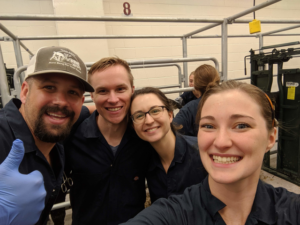 Each year, Texas A&M University hosts the nation’s largest student-led interprofessional emergency response simulation,
Each year, Texas A&M University hosts the nation’s largest student-led interprofessional emergency response simulation,  known as Disaster Day.
known as Disaster Day.
This event allows students from the colleges of Veterinary Medicine & Biomedical Sciences, Pharmacy, Public Health, Nursing, and Medicine to
 collaborate with the Corps of Cadets and the Texas State Guard to practice emergency response on a grand scale.
collaborate with the Corps of Cadets and the Texas State Guard to practice emergency response on a grand scale.
This year (on Friday, Feb. 14) was my second time attending Disaster Day.
Each year, there is a unique catastrophe presented for students to manage.
 This year’s simulation was an earthquake that resulted in
This year’s simulation was an earthquake that resulted in
building collapses and a train derailment; last year’s event was a research plant explosion that devastated the entire
neighborhood.
With actors covered in makeup and bandages, as well as first responders, hard-hats, and mock animal cases, this “disaster” teaches students the appropriate response skills needed for

such situations and allows them to learn the interprofessional channels of communication required when an entire community is affected by crisis.
The Texas A&M Veterinary Emergency Team (VET) provides some of their actual medical response units for day. These trucks are outfitted with medical equipment and supplies needed for stabilizing and treating animals in the field during a
crisis.
 During Disaster Day, we had to triage animal cases according
During Disaster Day, we had to triage animal cases according
to the severity of their wounds or diseases and then chose
treatment plans according to what supplies we had on hand. Sometimes these animals had diseases that were transmissible
to humans, requiring us to collaborate with the human medical
doctors and public health
officials on the proper containment protocols as well as owner education or care.

As a third-year veterinary student, I am about to leap into my final clinical year before graduation.
I think it’s invaluable for veterinarians to receive training in emergency response and become better prepared to take leadership roles in the community when the unexpected happens.
Events like Disaster Day are fun and exciting ways for me to apply my knowledge and feel equipped to serve my community when it needs me most.

 here at Texas A&M University!
here at Texas A&M University!
 arrange these experiences is through their annual job and externship fair. This weekend, more than 130 practitioners will converge on our school in the hopes of setting up externships with veterinary students and finding new graduates to hire.
arrange these experiences is through their annual job and externship fair. This weekend, more than 130 practitioners will converge on our school in the hopes of setting up externships with veterinary students and finding new graduates to hire.